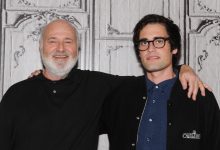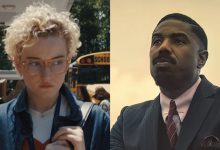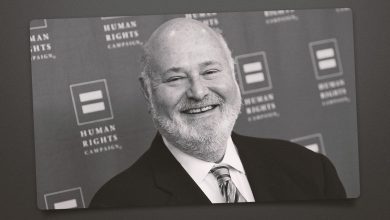‘The Penguin’ Director Craig Zobel Wrote a Fan Letter to Matt Reeves After Watching ‘The Batman’
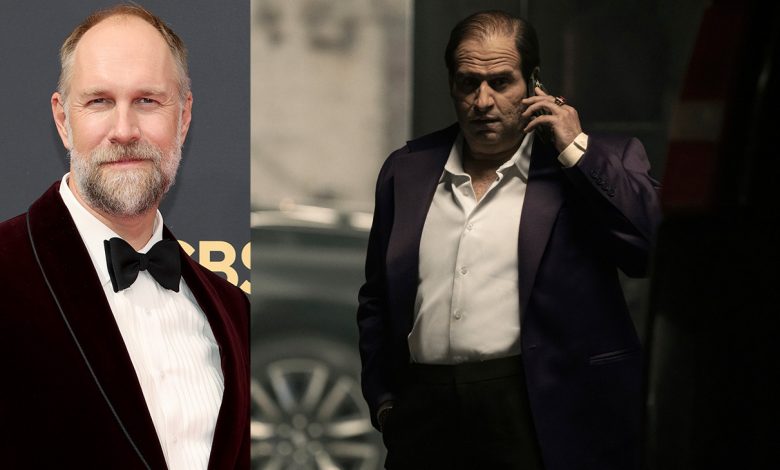
In March 2022, Craig Zobel returned home from seeing Matt Reeves’ The Batman during its opening weekend, and he immediately emailed the filmmaker to express his admiration for the superhero crime drama. Mind you, the Emmy-nominated director behind 2021’s Mare of Easttown and 2020’s controversial horror satire The Hunt didn’t know Reeves in the slightest, but this type of gesture is fairly common in the entertainment industry. Case in point, Cillian Murphy once emailed John Krasinski to compliment A Quiet Place, before he ended up co-starring alongside Emily Blunt in the sequel, A Quiet Place Part II.
So when it came time to hire directors for Reeves and showrunner Lauren LeFranc’s The Batman spinoff series, The Penguin, starring Colin Farrell as Oz Cobb, Zobel likes to think that Reeves potentially took note of that email before blessing his hiring as director and executive producer.
“I happened to have his email. So I reached out to say, ‘Hey, not for nothing, [The Batman] was the superhero movie I wanted to see right now. You killed it.’ That was my first time saying anything to Matt at all,” Zobel tells The Hollywood Reporter.
As the director of LeFranc’s series premiere, plus writer Erika L. Johnson and Noelle Valdivia’s second and third episodes, Zobel had a rather unusual task in front of him. Typically, the director of a series premiere or pilot establishes the overall aesthetic that future in-house or guest directors adhere to for the most part. But since The Penguin was directly connected to Reeves’ blockbuster movie, Zobel had to adapt to that existing palette like he’d done as a guest director on HBO’s The Leftovers and Westworld. Fortunately, Reeves and his DP Greig Fraser were at Zobel’s disposal in order to help maintain visual continuity. (Oddly enough, Zobel’s own work on Mare of Easttown was recently mimicked by writer-director Jac Schaeffer and Kathryn Hahn in an extended portion of Agatha All Along’s series premiere.)
“We talked with Matt and [The Batman DP] Greig Fraser a good bit before starting the show, and we asked them questions just on a very technical level,” Zobel says. “So we used all of the same camera gear and lenses that are in the movie, and as far as lighting styles and stuff like that, I would say that we carried that through, even if the scenarios were slightly different.”
Those scenarios include more of Gotham City in the daytime, including the lower-income neighborhoods within the city and the higher-income suburbs that surround the city.
The Penguin himself, Farrell, recently told a story about how he felt upon finishing season one, and at the time, he convinced himself that he was done playing Oz Cobb due to the enormous burden of the prosthetics and body suit. He’s since walked that statement back while also stressing that the series was intended to be limited, but Zobel is now shedding some more light on why the actor has such a love-hate relationship with playing Cobb.
“We were shooting in the winter, but he would get so hot because he literally has a pound of plastic on his face and he is wearing a bodysuit and all of this stuff,” Zobel recalls. “So we ended up having to turn on the soundstage [AC], and all of us had to wear scarves and earmuffs, because we turned the temperature down as low as possible just to make it comfortable for him. There was also the persistent threat that if he got too hot, he would start sweating and then that would make the [prosthetics] detach. That never happened, but it was always in the back of my mind.”
Below, during a recent conversation with THR, Zobel also discusses his desire to continue on in James Gunn and Peter Safran’s new DC Universe, especially if it were to involve one particular DC Comics imprint. Then he explains why any comparisons between The Penguin and other acclaimed series like The Sopranos, The Wire and Breaking Bad are purely coincidental.
Normally, as the director of a series premiere or pilot, you set the tone, and establish the look and feel. But, in this case, you had to take your cues from Matt Reeves’ The Batman, at least initially. So was it strange to kick off a show with an existing canvas already in place?
It wasn’t strange to kick off a show with a starting place already because I liked the movie that it was based on so much. I thought Matt created such a cool tone, and he found a new way into Batman, so I was excited enough that I wanted to chase it. When Matt’s film came out, I went and saw it on opening weekend. I didn’t know him, really, but I happened to have his email. So I reached out to say, “Hey, not for nothing, this was the superhero movie I wanted to see right now. You killed it. It was great and really cool.” That was my first time saying anything to Matt at all.
So I was excited to be a part of what that was, and as we started to put together our story, it was like, “Oh, this is actually from a different place. This is not the point of view of the Batman or a very rich Bruce Wayne. The Batman runs around at night after the sun goes down.” So we had to deal with really practical things like what happens during the day, and this version of the Penguin isn’t what we had seen prior to this. Even in the movie, he’s peacocking a lot. He dresses quite flamboyantly, he has this crazy purple car and The Penguin shows you that he was a very mid-level guy who’s from the streets and has really pulled himself up by his bootstraps. So what does that look like? And what’s the difference between what Matt was doing and where this story has to go? So it was really fun, actually, and it was an interesting challenge.
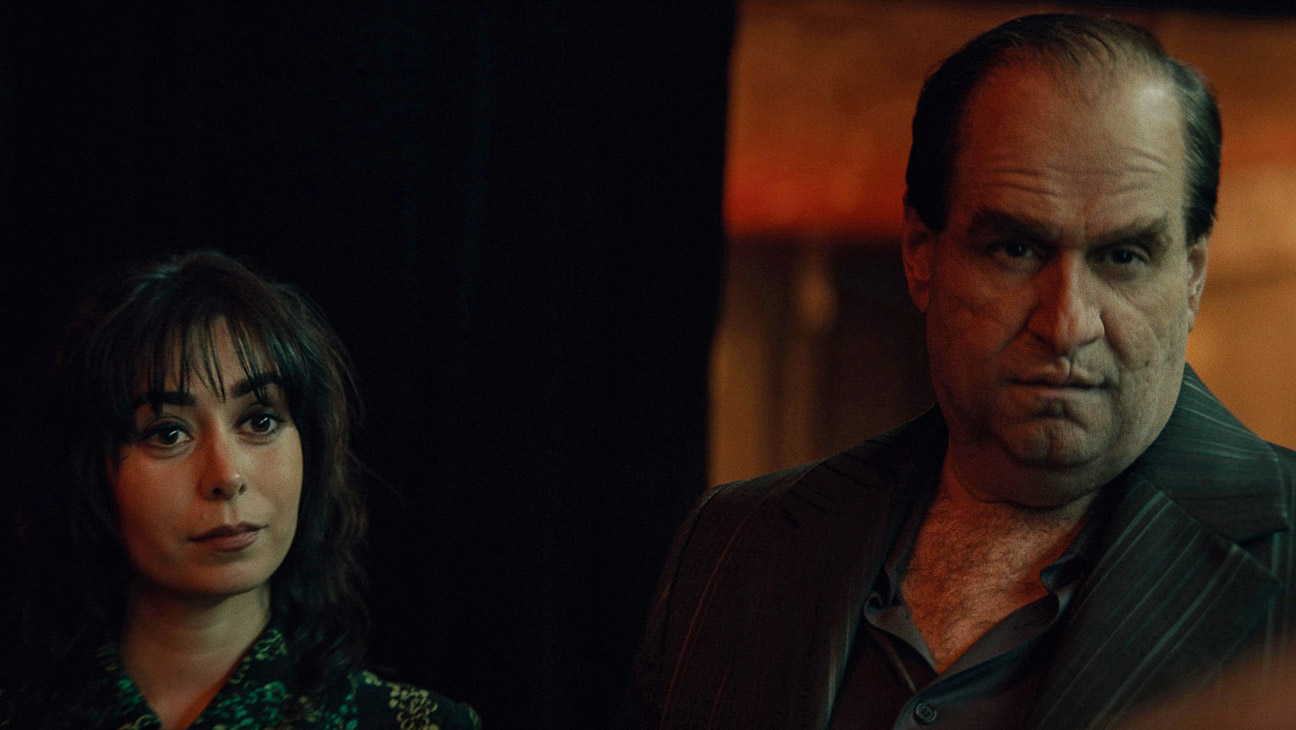
Backing up a second, do you think Matt filed your email away in the back of his mind and revisited it when it came time to hire directors?
I don’t know. I hope so. I think so, yeah. He certainly already knew that I liked it.
Matt’s movie had a lot of night shoots, rain machines, amber lighting and gothic locations in Liverpool. There were also a lot of cityscape shots via the Volume. So how difficult was it to maintain visual continuity in a new medium?
Well, we did some things very deliberately. We talked with Matt and [The Batman DP] Greig Fraser a good bit before starting the show, and we asked them questions just on a very technical level. So we used all of the same camera gear and lenses that are in the movie, and as far as lighting styles and stuff like that, I would say that we carried that through, even if the scenarios were slightly different. We tried to apply at least some of the toolkit that they used in whatever situation we were in, and because it’s a TV show, it’s just bigger. You’re going to encounter different scenarios so many more times, so we did our best. [The Penguin] feels like it’s inside of the Venn diagram and maybe is a little bit over here, but it felt like the way to have this visual continuity. It was also a TV show in the sense that we probably needed to move at a little bit faster pace than [Matt] was. We didn’t really have the same luxury that a movie does in that way. But it was honestly really fun to be like, “Well, what is the essence of [The Batman] and how do we do that in the time we have?”
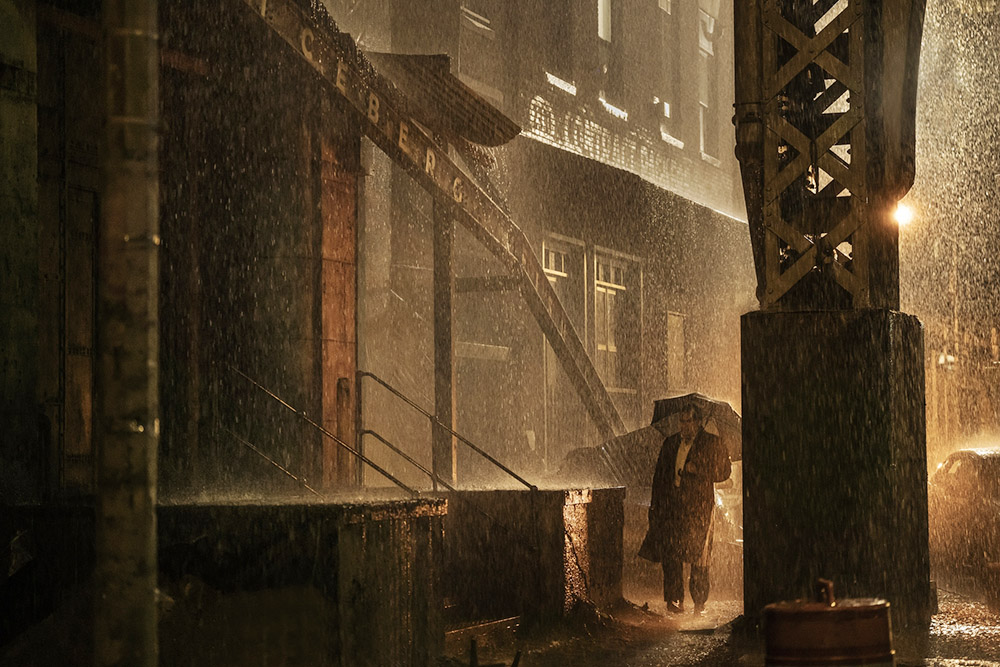
There’s also some repurposed footage from The Batman, such as the series premiere’s opening shot of Oz in the window at dawn. (The same can be said of The Penguin’s news footage, which reused Reeves’ shot of Gotham Square Garden’s stage being destroyed by the flood. Another example is the overhead shot of the arena once the dust settled, as well as a different angle of Bella Reál’s press conference.) Overall, how much unused or used footage were you given?
That’s pretty much confined to the very, very beginning sequence in the first episode, and we didn’t start with the knowledge that we were even going to do that. Over the course of pre-production, we realized that we needed to get everybody up to speed. The hope was to do something where you don’t need to have seen the movie to watch [The Penguin], but also doesn’t feel boring if you finished watching the movie five minutes before you turned on the show. What are the CliffsNotes that we can share?
What considerations do you have to make for an actor who’s covered in extensive prosthetics? Do you have to work quicker for Colin’s sake? Are there certain movements he can and can’t make?
It turns out that a lot of things factor into shooting him. (Laughs.) There’s obviously the scheduling of it all. It’s four hours of his day. It’s three-and-a-half hours of just getting into makeup, and then he has to take it off every day and you can’t just rip it off. You’ll rip your skin. So there was that, which was wildly complicated, but it was also a fun challenge in a way. I was like, “Well, that sounds almost too hard to do, so let’s try to do that.” But something that popped up was that it was very hot for him. We were shooting in the winter, but he would get so hot because he literally has a pound of plastic on his face and he is wearing a bodysuit and all of this stuff. So we ended up having to turn on the soundstage [AC], and all of us had to wear scarves and earmuffs, because we turned the temperature down as low as possible just to make it comfortable for him. There was also the persistent threat that if he got too hot, he would start sweating and then that would make the [prosthetics] detach. That never happened, but it was always in the back of my mind. My fingers were crossed the whole time.
Late in the premiere, Oz is fully naked and tied up to a chair. Did the full body prosthetic add even more time to an already long process?
That took most of a day just to shoot that full body prosthetic. Between the face and the body, it was six-and-a-half hours or something.
Goodness gracious.
(Laughs.) Yeah, it was a lot. He also couldn’t move. He was locked into certain positions. He couldn’t just run around with that full body thing on; it wasn’t built that way. So it was quite a thing.
I presume you block shot all three of your episodes. Was your total number of episodes a response to helming all the episodes of Mare of Easttown and One Dollar? Did you not want to put yourself in that overwhelming position again?
I would do that again, but for this particular thing, [three] felt like the right thing to do for whatever reason. In my mind, this was the first act of the story, and I was excited to get to do that. I actually haven’t just done the first episode or pilot of something, but this was the first time that I was trying to do [the first three]. So I like both [ways]. Doing three episodes is still three episodes; it’s still a good chunk. So, every time I do [television], I learn more, and I feel much more confident in doing a whole series again at some point.
Not long after you signed on to direct, James Gunn and Peter Safran were hired to run DC Studios and oversee Matt’s “Elseworlds” label alongside their own DCU. Did you field notes from them at any point, or were you mostly tied to [showrunner] Lauren LeFranc, Reeves and [producer] Dylan Clark?
They were certainly around, and they were really supportive of the project. They have always been really excited about it. I don’t remember any particular notes or anything in any specific way, but for sure, they were part of the team and around. Back in the day, when I was a kid, I was a big comic book nerd, especially in terms of the Elseworlds and the stranger, darker DC stuff, like Vertigo Comics. So I’m excited to see what Peter and James do with that stuff, and I’m also excited to see if I can help in some way.
I think you should write an email to James like the one you sent to Matt.
(Laughs.) Yeah, you’re right.
Is there one particular DC character that you’d love to tackle?
There’s a couple. I’m definitely the most familiar with that Vertigo universe and the stuff in the darker side of [DC]. So that’s where my brain immediately goes.
James Gunn is a really good filmmaker, and I can’t wait to see what this new [Superman] movie is going to be. I’m sure it’s going to be awesome. If he makes a whole world out of what The Suicide Squad and Peacemaker are, I’m in. That sounds awesome.
At some point, you learned you were no longer making an HBO Max show; you were making a Max show. But then you eventually learned that you were making your fourth HBO show (The Leftovers, Westworld, Mare of Easttown). Considering the great luck you’ve at HBO, was this a welcomed change?
When you’re in the middle of making a show, you’re not really thinking about what kind of logo goes on the front of it, at least I wasn’t. But I’m excited that HBO is excited about the show and wants to support it in that way. It’s awesome.
We talked earlier about how you referenced Matt and Greig’s The Batman aesthetic, but I recently talked to Kathryn Hahn and co. about their new show, Agatha All Along, which pays tribute to your work on Mare of Easttown. The majority of the series premiere is Kathryn’s character doing her own take on Kate Winslet’s Mare Sheehan and imagining herself in a similar show called Agnes of Westview. Is it pretty flattering to now be the one who’s referenced?
A hundred percent. That’s amazing, especially when it’s by Kathryn Hahn. She’s the best. So that’s really, really flattering. I didn’t know about that, but that’s cool to hear.
The character even has a deceased son that weighs on her.
Amazing.
Some of your former collaborators are open to another season of Mare, while others think that it’s best to leave well enough alone. Do you lean one way or another?
In my brain, there’s definitely a possibility for that to happen at some point. It’s tricky. When you make a show, you define what a character’s big emotional wound is, and hopefully, there’s some amount of catharsis in the character at the end of the show. And so the question then becomes, “Well, how do you keep that going in a way?” But I can totally see that happening at some point, and I would be excited to see it.
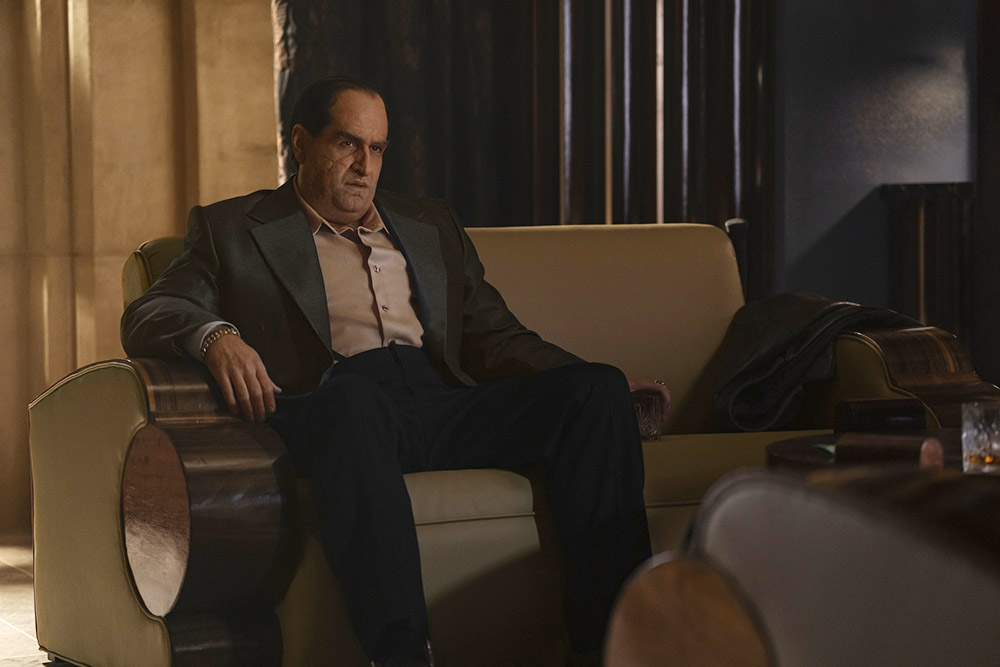
Returning to The Penguin, did you expect Oz’s opening monologue about Rex Calabrese to become the centerpiece of the trailer when you were shooting it?
Yeah, after we shot it, I was like, “Well, that was pretty good. Colin did a great job with that. That was pretty special.” It’s rare to have a monologue that long in any episode of a TV show, and we were doing it at the very beginning of our show, which was quite fun. It was the first thing we shot, too, so it was quite fun that way.
The title card also comes in at the perfect spot in the premiere. Was that scripted, or did everyone find it in the edit?
Yeah, in the screenplay, it says, “Ah, SHHH … cut,” or something. So we knew that the idea would be the end of the scene. Whether or not that was where we would put the title card, we didn’t know, but that was, for sure, where the scene would end. (Writer’s Note: In the actual premiere, Oz says, “Ahh, FUU!” before it smash cuts to the title card.)
As someone who hates cilantro, I really appreciate what you did for my community in episode two.
(Laughs.) Yeah, we did closeups of cilantro, and I remember those closeups.
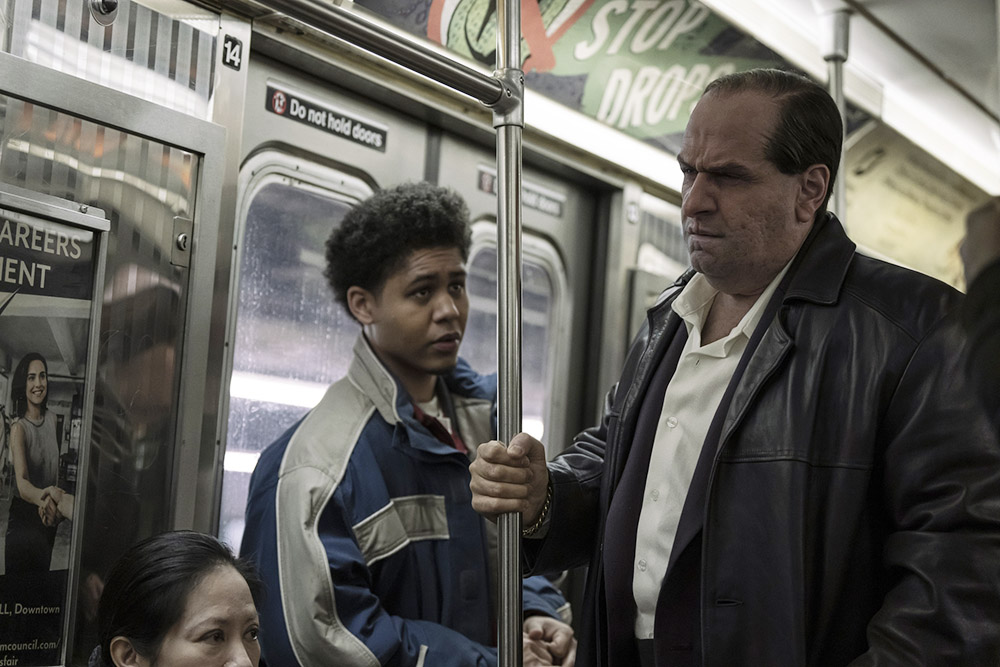
Victor (Rhenzy Feliz) reminds me a lot of a certain character from The Wire that I won’t identify. Did the creative team ever make that comparison?
Not directly, but I know what you mean. Maybe that was in the soup, as they say. It’s possible to look at the show and see things like that or The Sopranos, but we never really talked about that. We weren’t chasing that. I was always like, “Well, that’s just going to naturally happen.” So it wasn’t part of our lexicon; it’s just part of our cultural understanding. For instance, we were never like, “What did they do on The Sopranos for this or that?” Instead, I was just like, “Well, it’ll look like The Sopranos at the end just because that’s what we know.” But we were never chasing that, really.
To that point, the end of episode three is also reminiscent of a famous moment from Breaking Bad, except the character dynamics are reversed. Again, you probably didn’t have that in mind, but similar to what you said, it’s interesting how we all bring our own pop culture baggage into these things.
Yeah, it’s fun to be aware that certain things are going to work because they are sort of close to those moments, and it’s interesting to think about it like that.
***
The Penguin’s series premiere is now available on HBO and Max. Subsequent episodes will debut every Sunday.
Source: Hollywoodreporter
Related Posts
- Roundball Rocked: With NBA Return Looming, NBC Purges Scripted Roster
- SoundCloud Says It “Has Never Used Artist Content to Train AI Models” After Backlash on Terms of Service Change
- Fox News’ Camryn Kinsey Is “Doing Well” After Fainting on Live TV
- Kerry Washington and Jahleel Kamera in 'Shadow Force.'
Courtesy of Lionsgate
…
- This Alternative Artist Landed a Top-20 Chart Debut With an Album Made Almost Entirely on His Phone

